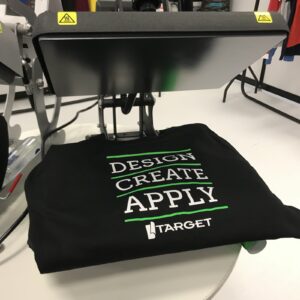 In this informative article, Andy Rogers, marketing manager at Target Transfers, outlines the basics you need to start your own clothing brand using heat transfers.
In this informative article, Andy Rogers, marketing manager at Target Transfers, outlines the basics you need to start your own clothing brand using heat transfers.
While thrilling, entrepreneurship can be a 24/7 commitment, so it’s important that you’re ready to start a clothing brand.
What you need to get started
To get started, you’ll need a heat press, some screen printed heat transfers, and blank shirts.
Decorating with a heat press is an easy, cost-effective way to enter the T shirt printing business. It allows for personalisation at scale on a wide variety of items and fabrics. Because of the ease of use and versatility, this is the go-to among start-up businesses and entrepreneurs.
With a professional setup costing just £600-£1,350. It’s the most affordable professional decorating setup available on the market.
What are heat transfers
With custom heat transfers, all you need to do is provide artwork. Once you are happy with your design, send it to your supplier and they will bring it to life. Then in your own time you just need to fuse it under a heat press for 10 seconds.
with custom transfers, there are three main types of transfers to look for: screen printed, digital and ultra-colour. All of these will last the lifetime of the T shirt.
- Screen printed transfers – Created with ink, screen printed transfers are printed onto release paper and applied with a heat press. They are great for large jobs over 50 pieces and graphics with 3 or less colours.
- Digitally printed heat transfers – Use solvent or eco-solvent based inks onto printable heat transfer vinyl, that is then cut, weeded, masked. These are perfect for creating full-colour logos on any fabric. The best job size for this is less than 50 pieces, unless it’s a large run of personalised items.
- Ultracolour transfers – Are a combination of the best qualities of screen and digital. Get the soft, detailed finish of screen with the unlimited colour and gradients of digital. This eco-friendly transfer is fast becoming one of the most sought-after transfer choices.
The right blank
Picking the right T shirt blank is an extremely important decision as you start your business. Some of the things to consider when sourcing your blank garments are fabric type, T shirt fit and sizing, and price and quality. Heat transfers can be applied to any type of fabric, just talk to your supplier, so they can make it block and/or stretch as required (for example, on athletic wear).
What to look for in a heat press
A heat press is a machine used to fuse a variety of heat transfers onto T shirts, bags, jerseys and more. When starting or growing your clothing brand, choosing the right heat press is essential. A heat press that delivers accurate time, temperature, and pressure will ensure a durable print every time, and repeat customers.
A quick check list should include:
- Over centre pressure.
- Digital readout of time, temperature, and pressure.
- Long warranty (at least five years on framework and 30 on the heating element).
 Pricing strategy
Pricing strategy
There are lots of variables that go into pricing your merchandise: your costs, overhead expenses, and what your competition is charging, to name just a few. Pricing strategies can be complex but the basic rules are straightforward. Your price must cover costs and give you profits. Review your prices often to make sure they’re still in line with your costs, demand, competition, and profit objectives.
When making an investment for your T shirt business, calculate the payoff to better understand your ROI. For example, if a press costs £1,350* and comes with a five-year warranty, your annual cost to own the heat press is £270 per year. *Based on 40x50cm Hotronix Auto Open Heat Press.
The payoff
To figure out how many sales you will need to pay off the cost of your heat press, take the total cost of heat printing tools and divide it by the profit per item. Follow this example to break it down further:
| Investment cost | Average order profit |
| Price of heat press: £1,350 | Average selling price: £20 |
| Price of accessories: £170 | Average cost per item: £6 |
| Total cost: £1,520 | Profit per item: £14 |
Number of items sold to payoff (total cost ÷ profit): 108 items or two per week.
For 108 shirts the average price for a one colour transfer would be £0.86, and a blank t-shirt would be £1.00.
If you think you can sell 109 T shirts, then you are ready to start.
 Printwear & Promotion The Total Promotional Package
Printwear & Promotion The Total Promotional Package




